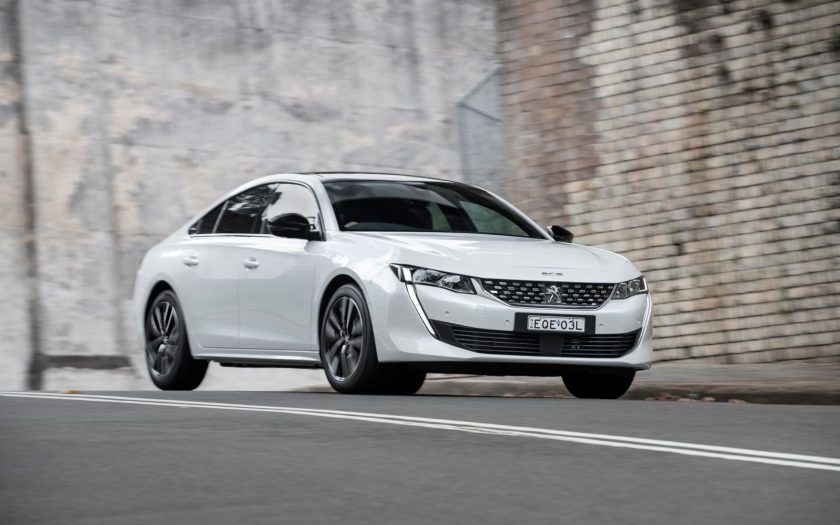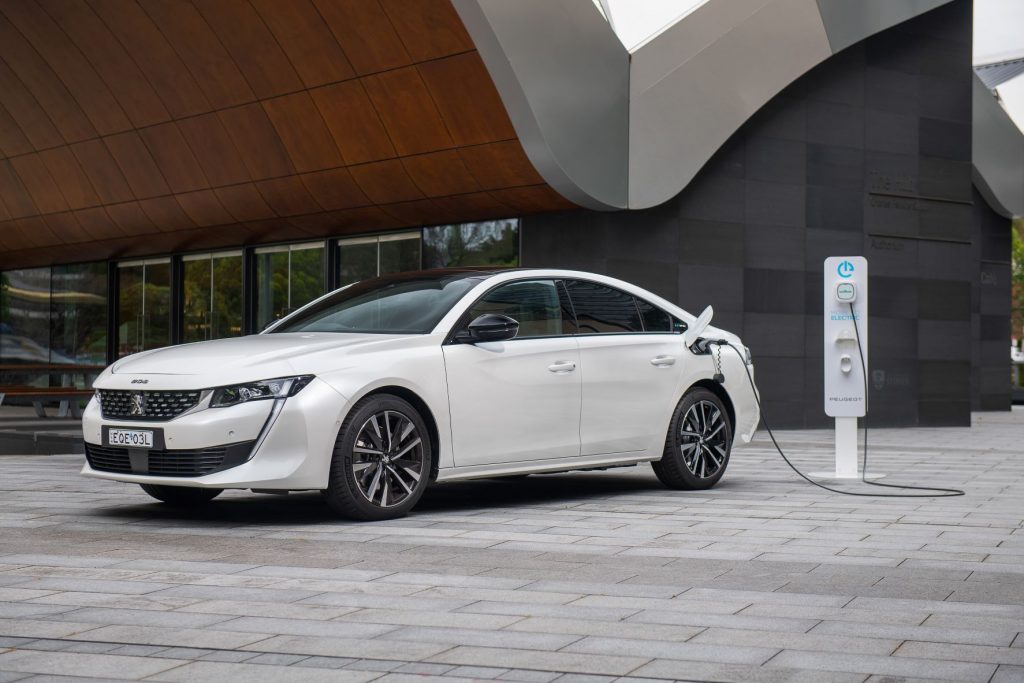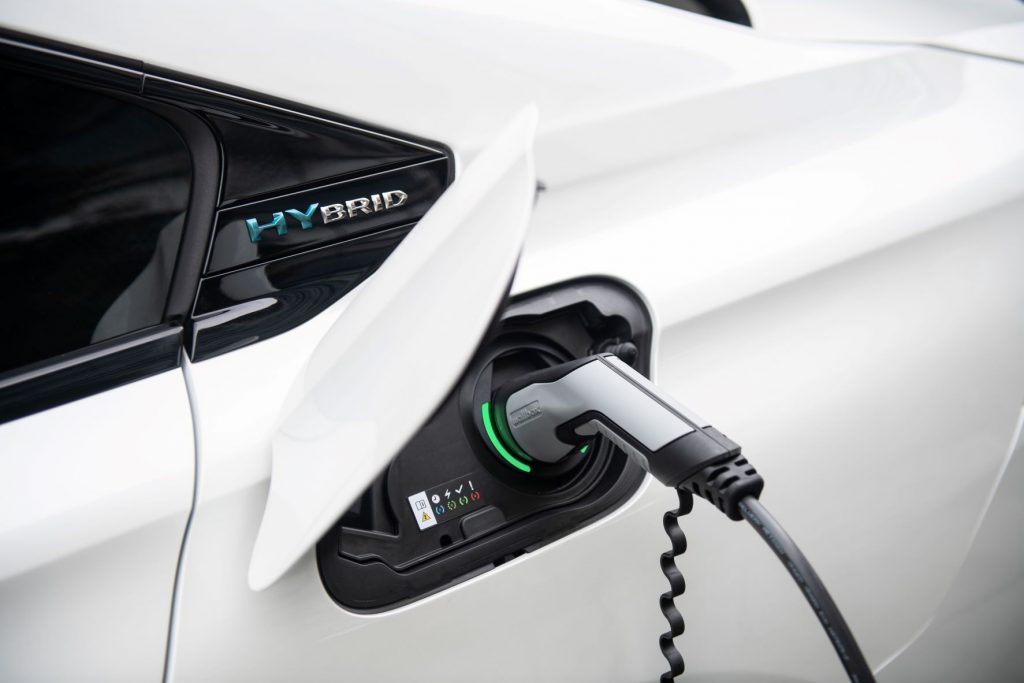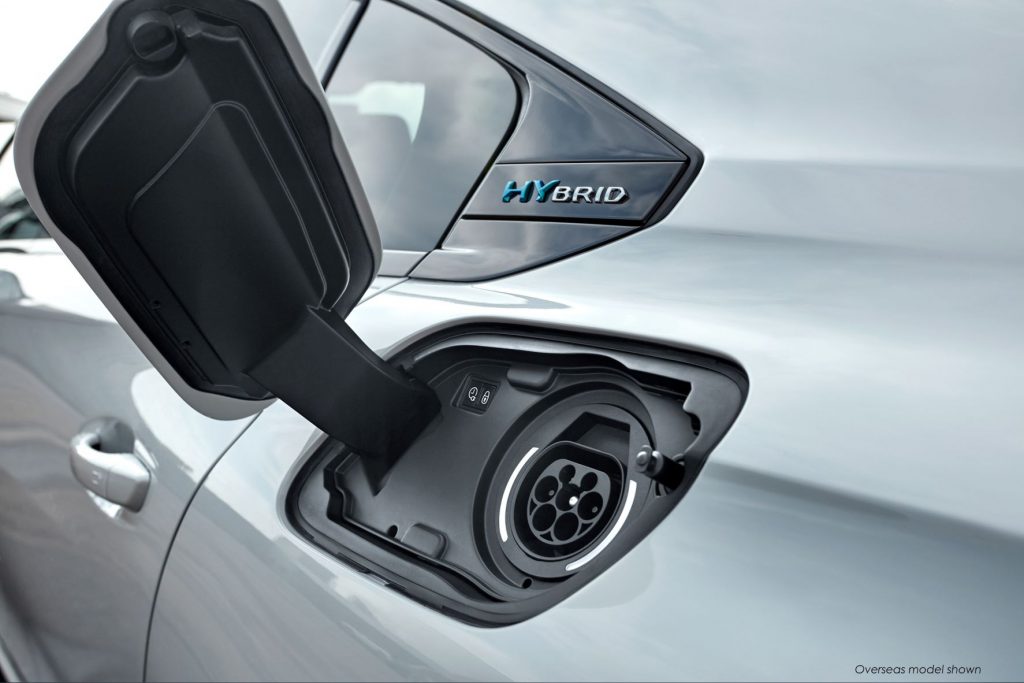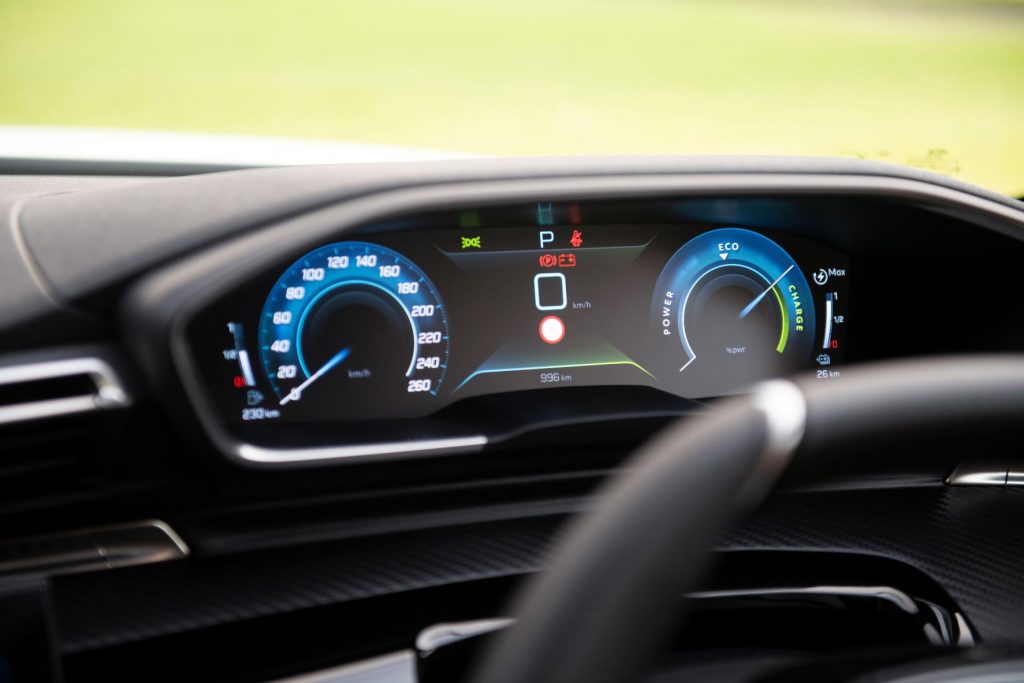Chris Riley tests the 2022 Peugeot 508 GT Fastback Plug-in Hybrid with pricing, specs, ride and handling, safety, verdict and everything the over-50 driver needs to know.
Summary: The Peugeot 508 is one of the very few PHEVs in the luxury sedan category, and that alone should see it selling well. But even though it’s much cheaper than the BMW and soon-to-arrive Mercedes-Benz models, it’s hard to see it being a sales star.
2022 Peugeot 508 GT Fastback Plug-in Hybrid
Pricing: $81,610 (Plug-in Hybrid, plus on road costs)
Options: Metallic paint $690. Premium paint $1050. Sunroof $2500
Warranty: Five-years, unlimited km. Eight-year/160,000km battery warranty. Five-years roadside assist.
Safety: 5 star ANCAP (tested 2018)
Build location: France
Engine: 1.6-litre turbocharged four-cylinder petrol, electric motor
Power: 133kW @ 6000rpm (ICE), 81kW (electric motor), 165kW (combined)
Torque: 300Nm @ 3000rpm
Transmission: eight-speed sports automatic
Body: 4750mm (long); 1860mm (wide); 1410mm (high)
Weight: 2270kg
Towing capacity: Unbraked: 745kg. Braked: not permitted
Wheels: 18-inch alloy
Tyres: 235/45R18
Ground clearance: 142mm
Turning circle: 10.8m
Battery capacity: 11.8kWh
On board charger: 3.7kW
Charging time: five hours (zero to 100 percent, 2.3kW Mode 2 cable)
EV range: 55km
Fuel tank: 43 litres
Claimed fuel consumption: 1.8L/100km (95 RON unleaded)
Consumption on test: 6.7L/100km (distance not stated)
seniordriver range on test: not tested
[review]
The Peugeot 508 GT Plug-in Hybrid is one of two hybrids now offered by the French brand in Australia.
As the move to electrification gathers momentum, the desire to be part of this movement is understandable.
You’ll pay a premium for the privilege, but new technology always come at a higher cost initially – remember how much flat screen TVs were when they were introduced?
The two plug-in hybrids are the 3008 GT Sport SUV and 508 GT Fastback.
The 3008 is understandable, given that it’s the biggest selling model in the range.
The latter is somewhat mystifying given demand for hatches and sedans is on the way down.
Peugeot has sold just 103 508s so far this year compared to 517 3008s.
What’s it cost?
It’s chic and sleek, sitting long and low with frameless door windows and coupe-like liftback.
To say it’s eye-catching doesn’t do the car justice. It’s almost a work of art. The inside is a study in design too.
But looking closer the design sacrifices quite a bit of practicality in the name of looks, with a narrow glasshouse that provides limited vision.
The windscreen is cluttered and the chunky A pillar blocks driver vision at critical moments, for example on roundabouts.
Over the shoulder vision is not terrific either, with even larger rear pillars and limited vision from the rear window.
Prices for 508 start from $63,431. The hybrid version kicks off at $81,610 – $18,179 more. And that’s not driveaway.
There’s also a wagon priced from $65,657, but it’s not offered as a hybrid.
Metallic paint is another $690, premium paint adds $1050, and if you fancy a sunroof – that’s a $2500 option.
As a second-string Euro brand one might be enticed to pay $60K for a 508, but by the time you add on-roads $85K is a helluva ask for a hybrid that will travel a maximum of 55km under electric power alone. As such, we don’t see Peugeot selling many.
At the same time, 508 is a good-looking thing, comes chock full of technology and is still way cheaper than a Benz or BMW if you’re shopping for a traditional sedan.
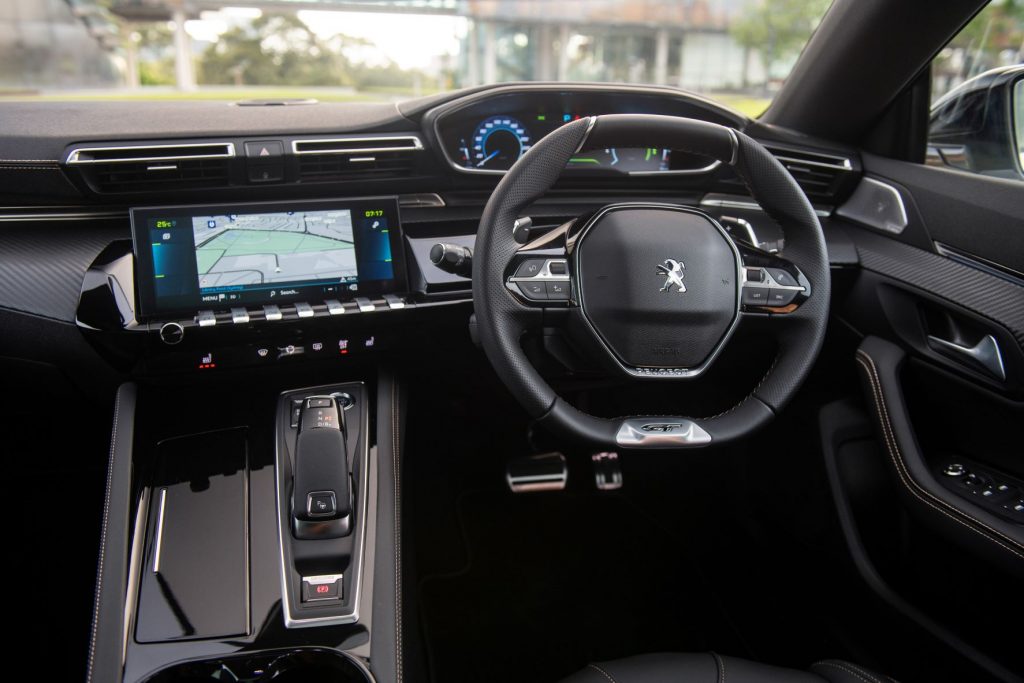
Standard kit includes double-stitched Nappa leather, two-zone climate air with rear outlets as well as a dust and pollen filter, power adjust front seats with massage and Focal 10-speaker premium audio.
There’s also 18-inch alloys (the turbo gets 19s), configurable 12.3-inch digital instrument panel, LED headlights and daytime-running lights, LED interior lighting and park assist (parallel and perpendicular), along with a power release boot lid.
Infotainment is taken care of by a 10.0-inch high definition touchscreen, with Bluetooth, navigation, digital radio, Apple CarPlay, Android Auto and Mirror Screen.
The Focal system pumps out 515 watts, with 10 speakers including a dedicated amplifier and subwoofer, plus two 12V sockets (dashboard and load area) and four USB Sockets (two in the front centre console, two in the rear centre console).
The 508 boasts a full suite of the latest safety features including six airbags, 180-degree rear-view camera and autonomous emergency braking (city, interurban and vulnerable road user).
There’s also adaptive cruise control with stop function, active blind spot detection, active lane keeping assistance, automatic high beam and speed sign recognition and recommendation.
It misses out however on rear cross-traffic alert.
508 is covered by a five–year/unlimited-kilometre warranty with five years of roadside assistance, plus an eight-year/160,000km battery warranty.
What’s it go like?
The standard GT with a 1.6-litre turbo delivers 165kW of power at 5500 revs and 300Nm of torque at 2750 revs.
With the help of an electric motor, the hybrid still puts out 165kW (but later at 6000 revs) while torque is boosted to 360Nm (also at 2750 revs).
The dash to 100km/h in standard form takes 8.1 seconds. The hybrid dispatches it in 8.3 seconds, mainly because it weighs another 271kg thanks to the battery array.
Fuel consumption for the turbo is 5.5L/100km. The hybrid with a smaller 43-litre tank is rated at 1.8L/100km and it takes premium unleaded.
BUT as we have explained in previous articles, the only way to get and keep getting 1.8L/100km is to recharge the battery every 100km.
Otherwise you’ll probably end up getting heavier fuel consumption than the turbo because the car weighs more.
With an 11.8kWh battery capacity, the hybrid offers an electric only driving range of up to 55km (WLTP), enough for the daily commute, it’s suggested?
Perhaps more importantly it helps the car to meet stringent Euro engine emissions standards.
The 1.6 PureTech engine is paired with the new 8-speed e-EAT8 automatic gearbox.
There’s four driving modes: Electric, Hybrid, Sport and Comfort.
Electric speaks for itself, while hybrid mode allows the driver to use the most efficient combination of electric or internal combustion engine depending on driving style and type of road.
Under certain conditions, the car can reach 135 km/h on electric power alone before the engine takes over.
Think of a long downhill run.
You can also recover energy from braking by selecting the B setting instead of Drive.
In this setting the car begins to brake as soon as you lift off the accelerator. It won’t bring the car to a halt, but with a little practice you can avoid using the brake pedal 90 percent of the time.
e-SAVE allows the driver to bank reclaimed power or use it straight away for improved performance.
Peugeot recommends regularly charging the battery to 100 per cent to experience the benefits of its electric capabilities.
Charging from zero to 100 percent takes about five hours via a 2.3kW Mode 2 cable.
You can charge using a standard powerpoint, home charger or commercial fast charger, but there’s not a lot of point forking out for a commercial charger because the charge rate is limited to 3.7kW – barely more than a powerpoint can provide.
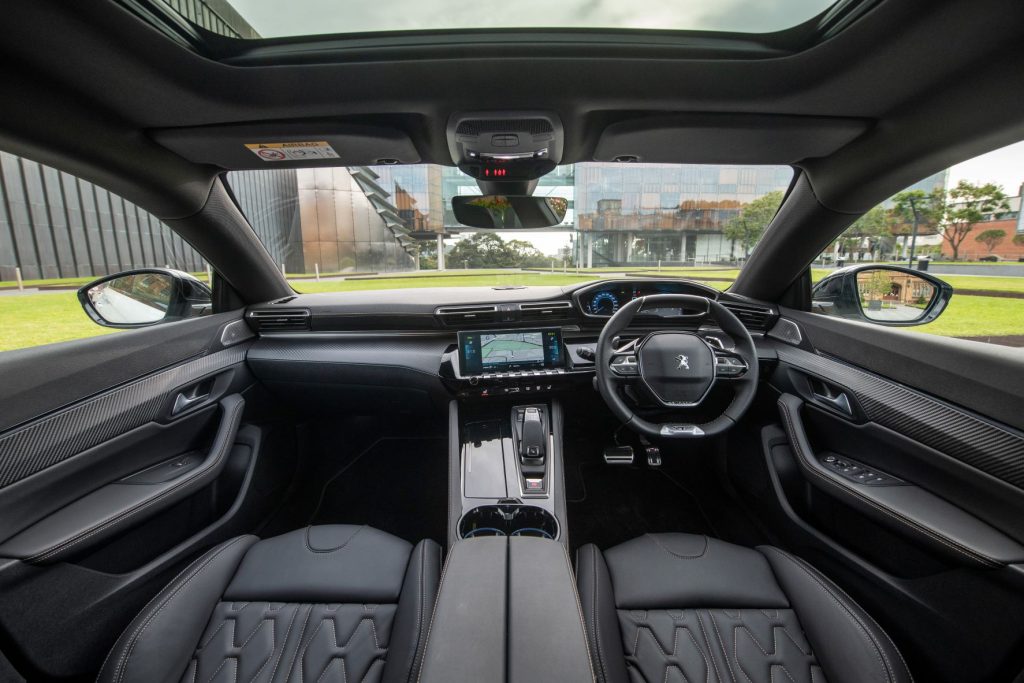
Getting into the 508 for the first time, the cabin and driver’s seat feel a little cramped.
Though good, the ride quality is not as good as the car we drove previously, despite being fitted with adaptive dampers.
Peugeot has championed its head-up dash layout which puts the instrument panel above the steering wheel, directing the driver’s line of sight over the wheel rather than through it.
But sitting there playing with the adjustment of the wheel it doesn’t look that elevated these days and, as someone who likes the wheel set high, pushing it up obscures the dials.
These same designers want me to look down at the central touchscreen rather than up, because the screen remains built into the dash rather than sitting on top of it as is the vogue.
Come on guys, you can’t have it both ways.
Then there’s the design of the touchscreen itself.
While there’s a physical volume button and a row of piano-style keys immediately underneath that provide quick access to various functions, the temperature controls are digital and flank either side of the screen.
You’d think they would be designed to disappear when reverse is engaged, devoting maximum real estate to the camera.
Alas, this is not the case. In fact, it gets worse when the overhead simulation kicks in, reducing the size of the camera even further, making it difficult to see, especially at night.
The dash can also be affected by glare because of the steeply raked windscreen which extends beyond it.
Sacre bleu!
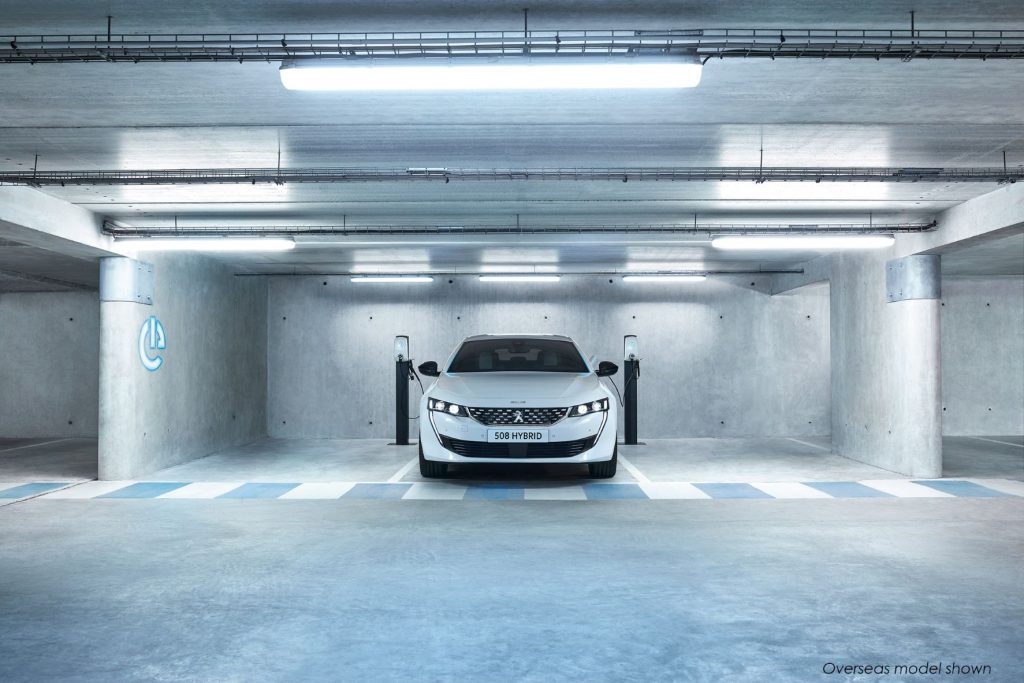
The design of the car actually dates back to 2019, pre-dating wireless charging and the move away from the silly Euro-style cruise control stalk.
Once you master its use it is okay, but try working out how to reduce distance to the car in front (on the move).
Looking for USB ports? You’ll find two in the front in a hidey hole below the centre console. There’s another two in the back below the rear air vents.
There’s also a 12-volt outlet in the centre console.
We enjoyed driving the 508.
The transmission can lag, frustratingly so in manual mode, often leading to double changes.
Ride and handling are excellent, but it’s more of a touring car than a sports machine.
We chose not to recharge the battery, setting it to hybrid mode to see how it performed with and without electric help.
The car was showing 6.0L/100km by the time we got it home and 6.7L/100km on its return.
What we like
- Looks fabulous
- Comfortable long-distance traveller
- Hybrid option reduces fuel consumption
What we don’t like
- Too expensive
- Style before practicality
- Poor vision
- Glare from windscreen
- Lacks wireless charging
- No school zone or speed camera warnings
- Fiddly transmission shift
- Try finding the control for cruise distance
- Lag when changing gears
What over-50s need to know
It’s too expensive.
A Camry Hybrid is cheaper and will return better fuel figures in the long run, but of course Camry doesn’t have the style or elegance of this French masterpiece.
If it was us and we just had to have one, we’d save our pennies and pop for the non-hybrid version. The $18K you pocket will pay for a lot of premium unleaded.
Hats off to Peugeot for having a red-hot go, however. Liberté, égalité, fraternité. Vive la révolution.
seniordriver comments
Plug-in hybrids are rapidly becoming the forgotten choice for EV buyers, and yet they often provide the best compromise for many buyers, particularly in Australia.
The electric motor has the capacity to get most commuters to work and back on pure electric power, and the internal combustion engine means PHEVs can be driven long distances without any range anxiety, or searching for the nearest recharge station.
However, PHEVs are notably thin on the ground in the luxury car segment. BMW’s 330e is probably the nearest competitor for the Peugeot 508, but costs a whopping $16,000 more. There’s a PHEV Mercedes-Benz A-Class (the A250e) for $68,989, but that is considerably smaller, as is the Cupra Leon VZe ($59,990 driveaway). The C300 e Mercedes-Benz is no longer available (although its replacement, the C350 e, is slated to arrive in 2023). Another contender, even though it’s an SUV, is Volvo’s XC60 Recharge PHEV for $97,990.
The Peugeot has a lot to recommend it, not least its stylish good looks, but there are some shortcomings as well. As usual, some practicality is sacrificed for style and as we are forever mentioning, we’re not convinced about the dinky little steering wheel with the instruments positioned above it. And as Chris points out, the reason for that design quirk is to maintain a raised eye level, an objective completely negated by having to look down at the central touchscreen.
Of course, price is a major hurdle, with the PHEV costing almost $20,000 more than the entry level 508. Pricing for metallic paint and premium paint is also a bit rich, especially at this price point.
Chris also makes a very good point that if you aren’t religiously attentive to recharging every 100km then your actual fuel consumption will fall well short of 1.8L/100km and possibly be even higher than if you’d bought a petrol version. Unusually, Peugeot recommend charging the battery to a full 100 percent charge (others tend to suggest 80 percent is more prudent).
One final word of warning: if you intend to do any towing, the 508 PHEV probably isn’t for you. Unbraked towing is limited to 745kg. And since braked towing is discouraged, that will be your limit.
